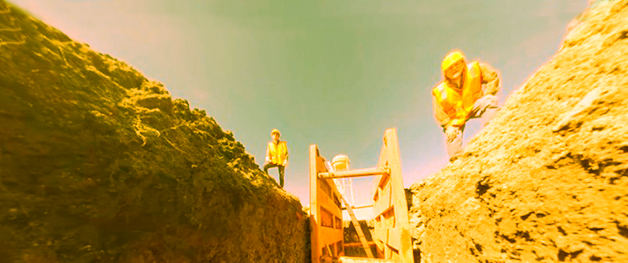If there’s a reason why trench-related construction fatalities have doubled in the past year, Occupational Health and Safety Administration’s (OSHA) Assistant Secretary Dr. David Michaels isn’t buying it. “There is no excuse,” Michaels said in a recent statement. “These fatalities are completely preventable by complying with OSHA standards everyone should know. It’s an alarming and unacceptable trend that must be halted.”

By December, the number of trench-related fatalities totaled 23 for the year, as compared to 12 in 2015. A dozen other workers reported trench-related injuries this year, three fewer than last year.
The issue came to a boil in late November, when OSHA cited Jamestown, Ohio-based KRW Plumbing for violations that resulted in the June death of a 33-year-old employee who was digging soil out of a 12-foot trench in Washington Township, Ohio. The walls surrounding him collapsed, burying him in thousands of pounds of dirt.
OSHA notes that among excavation hazards, trench cave-ins pose the greatest risk for injury or death, outnumbering falls, falling objects, hazardous atmospheres, and incidents involving mobile equipment. Among the reasons: “One cubic yard of soil can weigh up to 3,000 pounds — the weight of a small automobile — giving a worker little chance of survival when walls of soil collapse,” according to OSHA.

More plainly stated: “An unprotected trench is an early grave,” OSHA warns. “Do not enter an unprotected trench.” To ensure crew members don’t, contractors must comply with OSHA trenching and excavation requirements outlined in 29 CFR 1926.651 and 29 CFR 1926.652. Among other provisions, the standards require protective systems, including shoring or boxes, for trenches deeper than five feet. Additionally, soil and other materials must remain at least two feet from a trench edge to ensure they don’t fall back into it.

After a June investigation of the Washington Township fatality, OSHA concluded KRW Plumbing failed to provide trench cave-in protection to employees, to protect workers from excavated materials rolling or falling into trenches, and to train workers in recognizing trench standards.
During the investigation, OSHA discovered that a portion of the trench collapsed the same day as the fatality, though the worker who later died managed to escape without injury. “Agency inspectors also learned the same worker was involved in a trench collapse about a month earlier at another construction site, because trench cave-in protection was not provided, leading OSHA to open a separate investigation in October 2016,” the agency noted in a statement.
All told, OSHA cited KRW Plumbing for two willful and two serious safety violations. Proposed penalties totaled $274, 359.
Several of the year’s trench-related citations resulted from willful violations of OSHA standards. Some, as with KRW Plumbing, involved repeat offenders. In March, OSHA charged Chicago-based contractor Og Plumbing with three citations over a period of 18 days for failure to provide trench-protection at a job site in Oak Park. Ill. The agency placed the firm in its Severe Violator Enforcement Program.
Unlike a May trench collapse in Boise, Idaho, no injuries or deaths occurred on-site. The Boise incident involved the collapse of a 10-foot trench that killed two workers and injured a third who were performing below-grade utility work. OSHA determined that Meridian, Ohio-based contractor Hard Rock Construction Inc. failed to provide protection systems or a ladder to enter or exit the trench.
“I would like to say we found some surprises,” OSHA area director David Kearns told reporters. “We really didn’t.”
Editor’s Note: Industry members can learn more about trenching and excavation safety by accessing Fact Sheets issued by OSHA. To obtain copies, click here and here.


Discussion
Be the first to leave a comment.
You must be a member of the BuiltWorlds community to join the discussion.